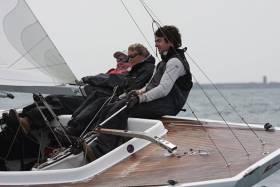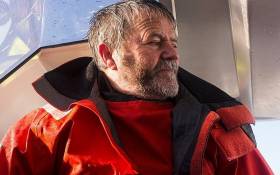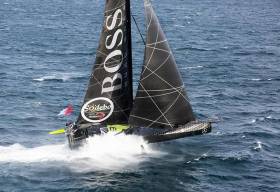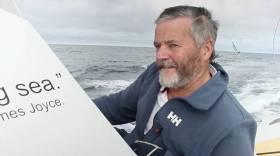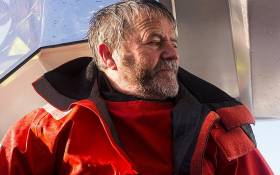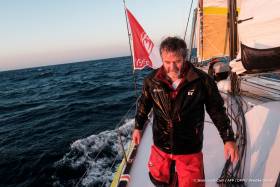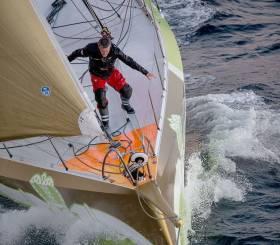Displaying items by tag: Enda O'Coineen
Neil O’Hagan Talks Tall Ship Plans, Enda’s Vendée Globe Challenge & More At Greystones SC Next Week
#SailingTalk - The next event in Greystones Sailing Club’s Winter Wednesdays series of talks hosts Neil O'Hagan of the Atlantic Youth Trust, the project that aims to bring about Ireland's next sail training tall ship.
O’Hagan is also on-shore co-ordinator for Kilcullen Team Ireland in the Vendée Globe, and he will have all the scuttlebutt on the highs and lows of Enda O’Coineen sailing Kilcullen Voyager, Ireland’s first entry in the round-the-world solo yachting challenge.
The date for diary is next Wednesday 25 January at 8pm, bar open from 7.30pm. You won’t want to miss it!
Enda O'Coineen Will Not Be First Irish Solo Circumnavigator
The current Vendee Globe Race non-stop round the world is deservedly attracting enough attention without having to make over-stated claims on behalf of some of its participants writes W M Nixon.
The official website is today carrying a story that if Enda O’Coineen can succeed in his plan of sailing his dismasted IMOCA 60 Kilcullen Voyager from Dunedin at the south end of New Zealand under jury rig to Auckland 800 miles away to the north, where a loaned replacement masts awaits, then if he can continue the voyage back to les Sables d’Olonne round Cape Horn he will become the first Irishman to sail solo round the world.
Not so. Noted Dublin marine artist Pete Hogan, who sailed solo round the world in his gaff ketch Molly B, said today that the number of misapprehensions about who was first doing what in the Irish circumnavigation stakes is astonishing.
For instance, when he rounded Cape Horn in the 1990s, he was acclaimed as the first Irishman to do it alone, for of course Conor O’Brien had done it with the crewed Saoirse in 1925. Yet Pete Hogan found it very difficult to get anyone to listen when he subsequently tried to set the record by saying that Bill King of Galway with the junk-rigged ketch Galway Blazer was the first solo, and that was way back in 1973.
The fact that Bill King was a distinguished former British submarine commander may have projected the image of being non-Irish. But in fact he flew both the Irish tricolour and the
British red ensign, and his home was Oranmore Castle at the head of Galway Bay.
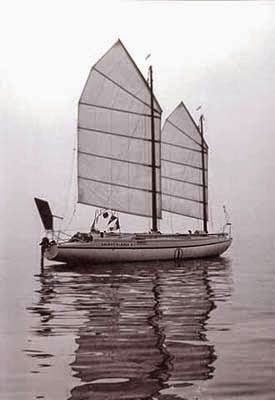 Bill King’s purpose-designed Galway Blazer circumnavigated the world solo south of the great Capes in 1973.
Bill King’s purpose-designed Galway Blazer circumnavigated the world solo south of the great Capes in 1973.
Since then, other Irish sailors who have striven to circumnavigate include Declan Mackell, originally from Portaferry but Canadian-based by the time he undertook his voyage in a Contessa 32, with which he returned home to Ireland for a prolonged stay during his circuit.
Another lone circumnavigator, Pat Lawless of Limerick who completed his voyage with a Seadog ketch in 1996 at the age of 70, had hoped to take in Cape Horn, but rigging damage forced him into a Chilean port, and eventually he returned to Ireland via the Panama Canal. But his circuit was definitely completed, and completed alone.
And Pete Hogan believes there may be one or two other Irish lone circumnavigators who have done it without fanfare. For not everyone seeks the kind of publicity which the Vendee Globe inevitably provides.
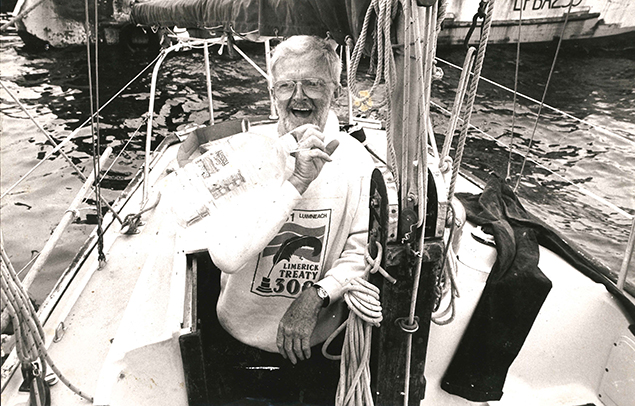 Limerick circumnavigator – the irrepressible Pat Lawless aboard his world-girdling Seadog ketch
Limerick circumnavigator – the irrepressible Pat Lawless aboard his world-girdling Seadog ketch
Replacement Mast Gets Enda O’Coineen One Step Closer To Record Books
#VendéeGlobe - Just days after admitting his “dream is shattered” after his dismasting off New Zealand at the halfway mark of the Vendée Globe, Irish skipper Enda O’Coineen is already preparing for a return to the water.
And as the Otago Daily Times reports, that’s all thanks to the kindness of Dunedin local Blair McNab, a plumber and yachtsman who read about the 61-year-old sailor’s plight and donated him a spare 9m mast.
Though smaller than his original rig, O’Coineen said it should be enough to get him to Auckland, where a replacement mast up to the task of the round-the-world offshore challenge might be sourced.
That would enable the first-time Vendée entrant to complete the route and sail Kilcullen Voyager back to Ireland, even if he’s no longer in official race contention.
"I’m the first Irishman to sail single-handedly halfway around the world — I’ve just got to do the other half,” he said.
The Otago Daily Times has more on the story HERE.
Ireland & Cork Sailing On A High As Vendee Globe Hits World Target
Enda O’Coineen may have exited the Vendee Globe in dramatic fashion on New Year’s Day when, as he drolly put it, Kilcullen Voyager stopped stone dead as she zapped into the back of a Southern Ocean wave, but his enormous mast just continued straight on with an almighty crash as it broke off clean at the deck. But this ruthless race continues on its way, and there’s still much of very specific Irish interest in it as the leaders approach the finish. W M Nixon gives us his own take on it all, and then tells us a tale out of school about Irish involvement.
It has to be the oddest geography lesson ever provided. And it has to be the most unexpectedly energetic way of promoting a relatively unknown region of France which was formerly almost exclusively associated with a relaxed way of life.
Once upon a time, the Vendee was a place which you’d usually associate with the gentler things in life. Things like good food and summer wine enjoyed in a sleepy siesta lifestyle in gently dusty villages inland from some fine beaches, villages where life moves slowly under the kindly shade of many trees, in a latitude which is not so far south as to be overly hot in summer, yet not far enough north to experience harsh winters.
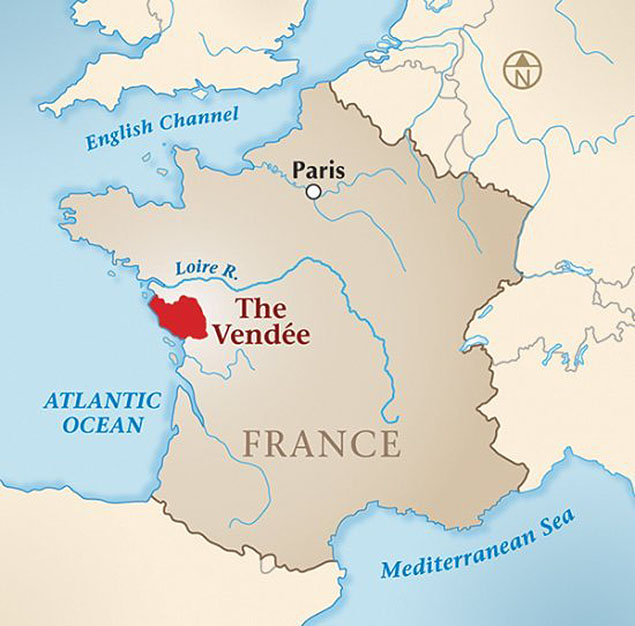 Little place that thinks big – France’s Vendee region has put itself firmly on the world map by sponsoring the Vendee Globe
Little place that thinks big – France’s Vendee region has put itself firmly on the world map by sponsoring the Vendee Globe
It’s about the size of an average Irish county. Yet right now, France’s modestly endowed Vendee region is being promoted as a place of world significance by extreme sportsmen taking part in a rugged sailing exercise with the most severe physical and life-threatening challenges, subsisting on a meagre diet which would rightly produce rioting in any self-respecting prison.
Welcome to the world of the Vendee Globe. That is, in the unlikely event that you aren’t already addicted to following it on a daily or indeed hourly basis. This still almost unbelievable round the world non-stop marathon continues to have an air of crazy novelty and enduring fascination, even though it was first staged in 1989.
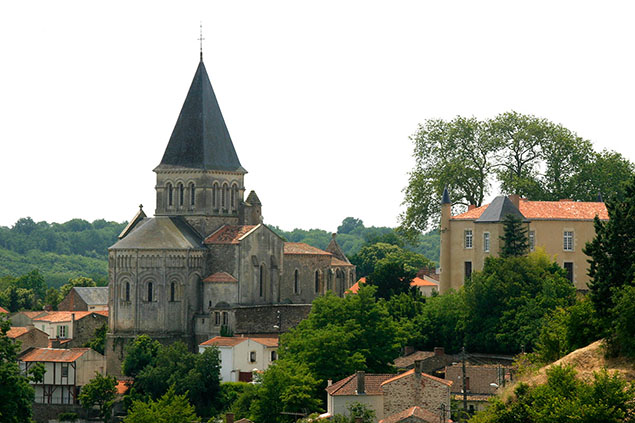 Peaceful countryside. Deep in the heart of the Vendee, the sea seems far away
Peaceful countryside. Deep in the heart of the Vendee, the sea seems far away
It boggles the mind to try and imagine the great French sailor Philippe Jeantot taking on the challenge of persuading the civil servants and politicians who run this relatively remote region of west France to permit, let alone sponsor, an event which is now utterly out on its own. Yet the regions of France quite rightly have an intense local pride. And if we in Ireland feel a tinge of envy at what they can achieve, just remember that last weekend it was announced that Wicklow Sailing Club had become the Mitsubishi Motors Club of the Year for 2017 thanks to their utter commitment to promoting the Round Ireland Race on a biennial basis, while at the same time continuing to function successfully as a club which caters for local sailing needs.
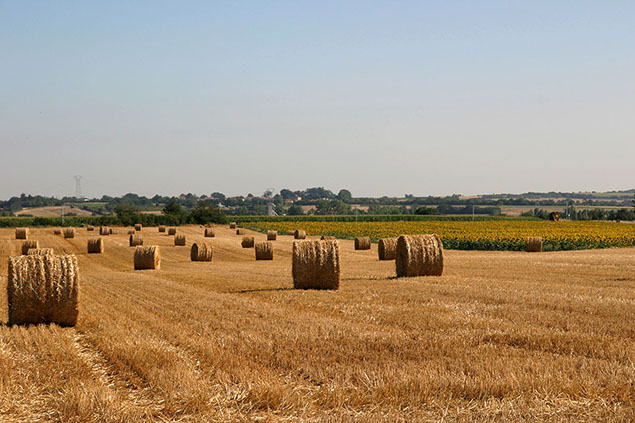 A summer cornfield in the Vendee is about as different as you can get…
A summer cornfield in the Vendee is about as different as you can get…
 ….from rounding Cape Horn in a rising gale. Yet both are linked through the world’s most challenging race
….from rounding Cape Horn in a rising gale. Yet both are linked through the world’s most challenging race
It’s something which is unusual in an overly-centralized country like Ireland, where all major decision are made in the capital, and in sailing you’d expect one of the main centres such as Cork Harbour or Dublin Bay or Belfast Lough to be the home of the Round Ireland race. But it is dogged little Wicklow which has won through, and 2016’s race fully justified their faith.
However, in the Irish context it is a local sailing club which is setting the pace. But in France, it is the regional administration which has been persuaded to pull off a remarkable coup. Looking at the scale and publicity which accompanies the Globe race, you’d assume it starts and finishes in a major centre such as Brest, or Lorient, or La Rochelle. Au contraire. The Vendee Globe starts and finishes in the very artificial sand-surrounded port of les Sables d’Olonne, set on a long sandy coast off which just about the only object of interest is the intriguing little Biscay island of Ile d’Yeu.
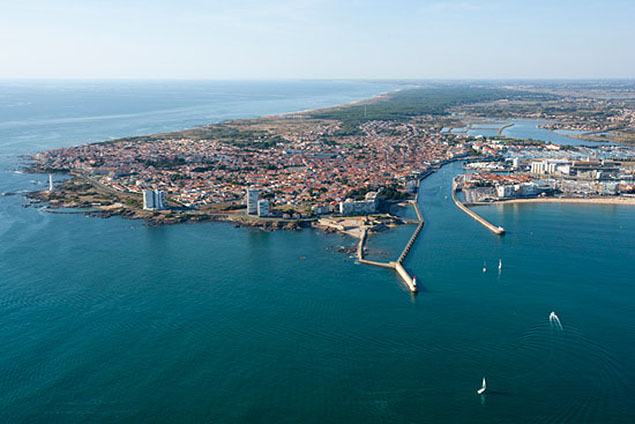 Les Sables d’Olonne, where the harbour is tucked in behind what used to be sand dunes
Les Sables d’Olonne, where the harbour is tucked in behind what used to be sand dunes
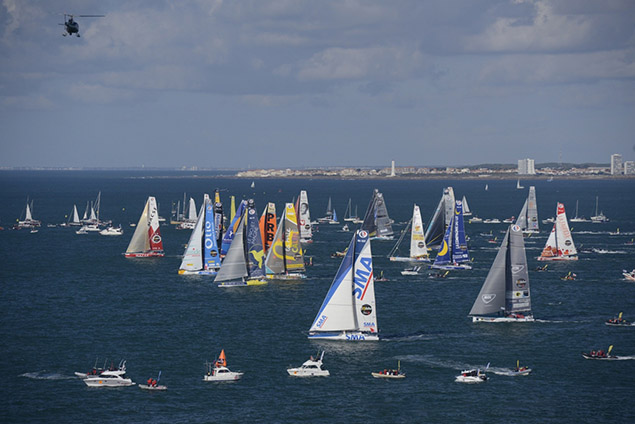 The start of the Vendee Globe 2016-2017
The start of the Vendee Globe 2016-2017
Yet despite the paucity of features of special interest along its sandy beaches, every three to four years sees Les Sables d’Olonne being swamped by hundreds of thousands of visitors when the Vendee Globe circus is in town. And this weekend, the focus sees the Race Headquarters move from their race-time base at the foot of the Eiffel Tower in Paris back to the quayside at Les Sables in anticipation of the finish, some time in the middle of next week, of the two fleet leaders.
Yesterday, gales on the Biscay coast prevented the re-installation of the super-tented Vendee Globe Village in Les Sables. But by today the command control should be broadcasting again on all media, and we can resume our daily doses of a fascinating event which is reaching its most crucial stage in an unexpected way.
For after a week in which severe storms have been sweeping most of Europe, a great big high pressure area is showing every sign of settling in over the southwest approaches to the Bay of Biscay right across the track which the two leaders – Armel le Cleac’h on Bank Populaire VIII and Alex Thompson closing up from 130 miles astern on Hugo Boss – will have to take to get to Les Sables.
C’est ridicule! The seas off northwest Spain - Galicia, Finisterre, whatever you want to call it – should be one of the stormiest places in the world in the latter half of January. Yet here it is, in an increasingly benign mood, with the final stages of the world’s breeziest race threatening to become a battle of the zephyrs.
 Enda O'Coineen and Stewart Hosford in Cork Harbour in 2015
Enda O'Coineen and Stewart Hosford in Cork Harbour in 2015
Under time-honoured traditional yacht racing tactics, all Le Cleac’h need to do is keep re-positioning himself so that he is directly between Thomson and the finish line. But these are not traditional yachts. Even in a zephyr, they can virtually create their own wind, and if the leader really does become so completely and utterly becalmed that he loses steerage way, the second-placed boat knows that his primary objective must be to maintain way even if it means actually heading away from the finish.
However, let’s face it, it is January, and it’s unlikely the total calm you might experience in high summer will ever settle in. That said, for le Cleac’h the situation is hugely challenging, for if there is one other skipper in the entire race who has the ability to pull off an audacious coup and snatch the lead, then it is 42-year-old Alex Thomson.
And in a sense, here in Ireland we can look on him as one of us. For five formative years of his childhood, he lived in the Crosshaven area, and his name can be found in the register of Templebreedy National School. His father Peter was a helicopter pilot on air-sea rescue duty, which meant that Alex was born in Bangor in North Wales as his father at the time was flying out of Anglesey, but then the move came to Cork airport, and the young Alex saw his first sailing off Weavers Point.
Sailing the seas of Cork at that time was young Stewart Hosford whose father Bill was one of the crew on Denis Doyle’s blue S&S designed Moonduster. Bill Hosford was also one of the consortium involved with Barry Burke in building the Ron Holland-desined Shamrrock racer-cruiser range, while for some added interest Bill and his wife Ann for ten years owned that deservedly renowned West Cork hostelry Mary Ann’s in the picturesque village of Castletownshend.
However, the challenge of life as an international banking executive drew young Stewart away from Cork, and he spent fifteen years in the City of London and another five in Edinburgh before the call of the sea returned, and he and his mates bought the Farr 65 Spirit of Diana in 2000 and linked up with the recent winning skipper in the Clipper Round the World Race, one Alex Thomson, to go racing. The rest is history.
 “Alex does the sailing and the stunts…..” A spot of keel-walking with Hugo Boss
“Alex does the sailing and the stunts…..” A spot of keel-walking with Hugo Boss
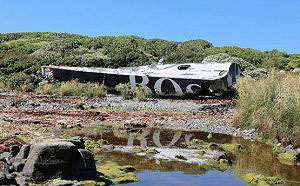 Even when things don’t go quite according to plan, somehow it still seems a success…
Even when things don’t go quite according to plan, somehow it still seems a success…
The synergy between the two men in creating a boat racing organization is extraordinary. Even though Stewart is now based back in Cork, life is totally peripatetic as he fulfills the role of CEO of Alex Thomson Racing, while Alex does the sailing and the stunts, and Sir Keith Mills is the third corner of a remarkable triangle for creating success.
The well-established link-up with Hugo Boss completed the package, and while on occasion things have gone spectacularly wrong, there’s something about an Alex Thomson Racing failure which makes it into a success. The man himself has a superhuman dedication and determination, and an ability to think completely outside the box, which makes their involvement in any event add greatly to its success.
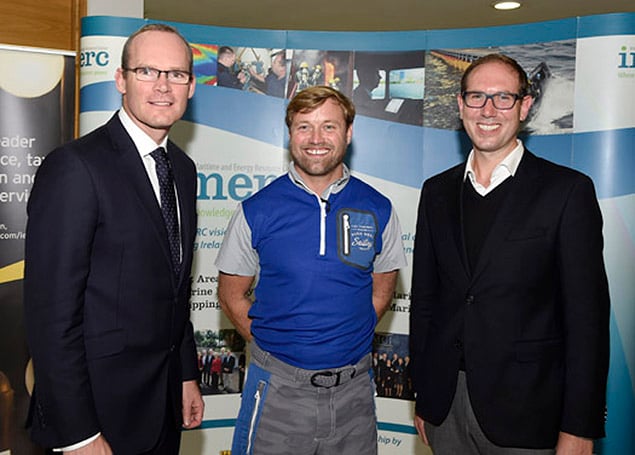 The then Minister for the Marine Simon Coveney with Alex Thomson and Stewart Hosford at a press briefing to put forward some proposals for developments on Cork Harbour
The then Minister for the Marine Simon Coveney with Alex Thomson and Stewart Hosford at a press briefing to put forward some proposals for developments on Cork Harbour
Most of us have lost count of how many different boats called Hugo Boss there have actually been, but there’s no doubt the current boat – after some setbacks which would have rebuffed a lesser squad – has evolved into on of the most formidable racing machines on the planet.
So even though it’s unlikely she’ll get starboard tack all the rest of the way to the finish in order for her lack of a starboard foil not to be a disadvantage, Hugo Boss racing has now reached such a level of attention that any outcome is ultra-newsworthy.
But though we talk of the Alex Thomson Racing challenges having reached a certain kevel, staying level is that last thing on the minds of these guys. They’ve all sorts of other ideas taking shape, and their track record is such that if they were so inclined, they could make a tidy living as consultants to nascent challenge projects. That is most unlikely. They’ve moved on a long way from Templebreedy. But even so, it still means a lot to Alex Thomson and Stewart Hosford when the latest Hugo Boss puts in an appearance at Crosshaven.
 Enda O’Coineen’s Kilcullen Voyager and the previous Hugo Boss off Crosshaven, where Alex Thomson spent five years of his childhood.
Enda O’Coineen’s Kilcullen Voyager and the previous Hugo Boss off Crosshaven, where Alex Thomson spent five years of his childhood.
#VendeeGlobe - Enda O’Coineen says “it's a real possibility to finish what I started” despite the devastating mast break that took him out of the Vendée Globe on New Year’s Day.
The Kilcullen Voyager helm was forced to cut the rig free to protect the hull after dismasting some 180 nautical miles south-east of Dunedin in New Zealand — ending Ireland’s first ever challenge in the round-the-world solo yacht race at the half-way point.
In his final race log, the 60-year-old businessman described how the incident left him “shaken and struggling to get back to New Zealand”, with no motor on board and many miles from rescue.
However, 40-knot winds over the last few days helped to push his drifting vessel into range of a Dunedin trawler, on board which he was expected to reach land this morning (Friday 6 January).
Speaking to the Press Association ahead of his arrival, he confirmed comments from his last log that he wants to complete the race course, even if he is formally out of competition.
"It's a real possibility to finish what I started but it's a massive undertaking to do the repair," said Afloat.ie’s Sailor of the Month for December. "But I'm nervous about saying I'm going to do that.
“Doing that, resourcing it, making it happen, there's a lot of sacrifice for the family and all of that but that's one real alternative I'm contemplating."
Replacing the rig is one of three options open to O’Coineen, which include shipping the broken boat home, or leaving it behind.
Enda O'Coineen is Sailor of the Month for December
For months now, Enda O Coineen’s campaign in the Vendee Globe with the veteran IMOCA 60 Kilcullen Voyage has captured public imagination as the resilient 60-year-old lone sailor has battled the challenge of a lifetime in the most demanding sailing event in the world. By December, his progress had become a part of everyday life for his thousands of followers in Ireland and abroad. Far from being a dogged account of endless struggles with ferocious weather and the inevitable gear failure, his reports were often laced with lively humour, unflinching self-analysis, and the occasional highly entertaining declamation of poetry in mid-ocean.
As December progressed, his placing in the race continued to improve as others of the 29 starters fell by the wayside. It was becoming increasingly likely that if he eventually made it to the finishing line in Les Sables d’Olonne, he would have got into single figures on the leaderboard. December 9th was surely the highlight, when he logged 395 miles in a single day. But then, following a complete knockdown, one problem after another followed, and he’d to divert to Stewart Island off the southern tip of New Zealand for a day’s shelter and essential repairs.
The jobs done, he was on his way again as December drew to a close when a sudden squall from a new direction and a self-steering malfunction caused a couple of crash gybes, the second resulting in a total dismasting with the entire rig having to be cut away in violent seas. Eventually, resorting to engine power soon resulted in a stray rope jamming the propeller. Yet with a jury rig using spare mainsail battens as masts, he has been able to make his way unaided back towards New Zealand, where he will be brought into port with a pre-arranged tow from a fishing boat.
His spirit in the midst of these setbacks is reminiscent of Ernest Shackleton at his best. We’re well aware that a year ago, we made Enda O’Coineen January “Sailor of the Month” for his success in qualifying for a place in the Vendee Globe thanks to a third place in December’s Transatlantic Race. But his unsinkable spirit deserves a second award as our final gesture to what he has achieved in 2016.
Enda O'Coineen Dismasted, First Irish Vendee Globe Challenge is Over (Update at 1600hrs)
Enda O'Coineen has been dismasted on New Year's Day off New Zealand bringing to an end Ireland's first ever Vendee Globe Challenge at the half way stage of the solo round the world race.
O'Coineen reported to Race Headquarters in Paris at 0830hrs UTC that the mast of Kilcullen Voyager - Team Ireland has broken.
Over the past 55 days Enda has sailed 13,153 nautical miles (over 24,000 kilometres) alone, through some of the worst weather imaginable. He has overcome rigging issues, electrical issues, the mental challenge, but losing the mast is something impossible to repair.
His position is now some 180 nautical miles to the south east of Dunedin, New Zealand. He was racing in 35kts of SSE wind when the rig broke. The skipper is uninjured and reported that he was starting to secure his boat and the broken pieces of the rig and planned to head to New Zealand which, in the current weather situation, is downwind for him. He should have enough fuel on board for the journey.
Enda is in contact with the Technical Team and Race Direction. A full assessment of his situation is being made and more details will follow.
Update at 1600hrs
In a few unfortunate moments the Vendée Globe solo round the world race came to a premature end for Irish skipper Enda O'Coineen. A sudden, unexpectedly strong gust at 35kts of wind overpowered his autopilot, resulting in two crash gybes leaving no time to get a running backstay on to support the mast.
In seconds the mast of Kilcullen Voyager-Team Ireland is broken, falling over the side of the boat.
Lying in 15th place in the famous round the world race, which represented the pinnacle of his lifetime of sailing and adventuring, O'Coineen had only just completed a series of necessary repairs 24 hours earlier, whilst sheltered in the lee of Stewart Island, at the very southernmost tip of New Zealand. Ironically only two hours previous to his mast crashing down, he had made a New Year's video, promising to recalibrate his natural affinity for risk.
Having just effected his repairs – principally to his autopilot and computers - and actually having profited from his experiences and his solid speeds in the Indian Ocean, O'Coineen today spoke of his deception and disappointment, which are felt all the deeper and harder because he considered himself to be in good shape to take on the second half of his round the world race:
“I am devastated. Things were going quite well. O'Coineen said, “I was in good shape. Having got this far I felt we could handle anything. There was just that little malfunction of the self-steering that set a whole train in motion. I have to accept responsibility. What happens, happens.”
In terms of his Vendée Globe, setting out on the 5,000 miles to Cape Horn, O'Coineen, 60, is fortunate to have been a little less than 200 miles SE of Dunedin when his mast came down. He cut is rig free but reported that he did not save the boom, or any part of the mast, and so has very limited jury rig options. He was heading slowly downwind towards New Zealand this Sunday afternoon.
“You roll the dice.” He told Race HQ in Paris after prefacing his description of the incident by wishing all a Happy New Year. “I was caught a little bit unawares. I was in 20-25kts of breeze and a very vicious 35kts squall came through and the self-steering malfunctioned just at the wrong moment. I did an involuntary gybe and then a gybe back. The boat was out of control and I was caught without the runner properly on and the mast snapped. I have to laugh because if I don't I will cry. The mast came clean off at the deck and in fact it was intact. But the whole rig went over the side. I had the difficult decision to make whether to try and save the rig or whether to save the hull of the boat.”
O'Coineen's humour, philosophy and his larger than life character, his predilection for wearing his big and passionate heart on his sleeve will be missed over the remaining weeks of this Vendée Globe.
“Look, you have to be philosophical. This sort of sailing is living on the edge. I have been doing this for 57 days and as the fella says if you are living on the edge you are taking up too much space. I was taking up too much space on the edge.”
“Ironically I had just done a little interview with myself for New Year. I celebrated with a small bottle of champagne. My alter personality asked me what my New Year's Resolution is. And my New Year's Resolution was to take less risk with my life. In business, in my life, I have taken a lot of risk. The risk enabled me to make enough money to buy this boat, to pursue the dream and to pursue my adventure. Bizarrely, only two hours earlier, I had recorded a video pledging to take less risk. And here I am. Risk is a four letter word, like a lot of meaningful four letter words in the English language.”
Of the 18 boats still actively racing, 29 having started in Les Sables d'Olonne on November 6th, some eight weeks ago, the leadership battle sees Armel Le Cléac'h having gained 43 miles in the 24 hours to 14:00hrs UTC. Second placed Alex Thomson (Hugo Boss) will seek to minimise his time upwind on port tack because he has no foil to provide lift and traction.
Transcript from Enda onboard Team Kilcullen:
"You roll the dice. I was caught a little bit unawares. I was in 20-25 kts of breeze and a very vicious 35kt squall came through and the self-steering malfunctioned just at the wrong moment. I did an involuntary gybe and then a gybe back. The boat was out of control and I was caught without the runner properly on and the mast snapped. I have to laugh because if I don't I will cry. The mast came clean off at the deck and in fact it was intact. But the whole rig went over the side. I had the difficult decision to make of whether to try and save the rig or whether to save the hull of the boat. I thought of safety first. I cut the rig free from the boat. I was worried that the stump of the rig would hole the boat. The seas were pretty wild. There was a big sea running. I cut the entire rig free. I am mastless, the deck was holed. It is not a happy situation but there it is, you roll the dice. That is the risk you take.
I am devastated. Things were going quite well. I was in good shape. Having got this far I felt we could handle anything. There was just that little malfunction of the self-steering that set a whole train in motion. I have to accept responsibility. What happens, happens.
Look, you have to be philosophical. This sort of sailing is living on the edge. I have been doing that for 57 days and as the fella says if you are living on the edge you are taking up too much space. I was taking up too much space on the edge.
Ironically I had just done a little interview with myself for New Year. I celebrated with a small bottle of champagne. My alter personality asked me about my New Year's Resolution. And my New Year's Resolution was to take less risk with my life. In business, in my life I have taken a lot of risk. The risk enabled me to make enough money to buy this boat. to pursue the dream, to pursue my adventure. The irony is that only two hours earlier I had recorded a video to pledge to take less risk. And here I am. Risk is a four letter word, like a lot of meaningful four letter words in the English language.
What can you do? I have acted responsibly.
It is January 1st. It is a New Day and a New Year and it is time to move on. My Vendée Globe is over. I am appreciative of all the support I have had. "
Enda O'Coineen Diverts in Vendee Globe For 'Major Issue' Repairs
Enda O'Coineen has had to take the prudent, but tough decision, to turn back north in the Vendee Globe Race and separate away from the six strong pack of boats he had been racing closely with, playing tag with the back of that same depression. O'Coineen is diverting to Stewart Island, just off the tip of South Island New Zealand in order to make repairs and continue his race.
O'Coineen, who was lying in 11th place of the 19 solo skippers still racing, is seeking to complete a number of repairs, and aims to continue with his race. Stewart Island, which is some 19 miles south of the tip of New Zealand's South Island, is famous in the history of the Vendee Globe as it is where legendary French skipper Yves Parlier stopped for ten days during the 2000-1 edition of the race and repaired his broken mast with no outside assistance, before restepping it using his boom as a derrick.
None of O'Coineen's problems aboard Kilcullen Voyager-Team Ireland, in isolation, are considered race ending in themselves, but together they might endanger him during the 5000 miles between New Zealand and Cape Horn. Following the rules and spirit of the race, the intention of the Irish soloist is to complete his repairs unassisted and to continue racing. He spoke today of losing 'a couple of days'. The solo skipper has a NWW'ly wind of 25-30kts and is expected to arrive at Stewart Island some time late Thursday or early Friday.
O'Coineen said this afternoon: “It is really the accumulation of three weeks going through the Indian Ocean. I have had several small problems and together they have become a big problem. I have a problem with the self steering and with the mast track and with the communications and so I have made the very difficult decision to stop. I am not stopping the race. I will just make the repairs under my own steam. It was a choice between Campbell Island which is close to me (now) or Stewart Island which is to the south of New Zealand. It is a better anchorage and I don’t have much detail on Campbell Island. I was enjoying the race, getting up to 10th or 11th place, but now if I lose a couple of days I will lose a couple of days, but hopefully I will be able to effect these repairs. It is a good long haul to Stewart Island. In one sense I could have continued into the Pacific and to Cape Horn but this is my last jumping off point, so it would have been a huge risk. In the meantime I am doing what is the more prudent, seamanlike thing to do. I am torn apart with it. It is cold and wet and it is the middle of the night right now. It has not been a good day. That is what the challenge is. It will be a big job to do the repairs on my own but hopefully I can do that."
"It is an awful shame to be going there (Stewart Island) and not to stop for any length of time (laughs) but maybe there may be bonus there. We will be back soon. Hopefully we can make it all happen. The self steering system has to be recalibrated. The software is corrupted. I have to go to flat water. That is the first thing. At the spreader level I have a piece of the mast track which is broken about 18 inches. (45cms) The third main thing is when my reef broke I crash gybed and the lazyjacks broke. So to replace the mast track I have to climb the mast. I am making progress with the comms. So none of them alone is life threatening but the accumulation together is all pretty serious. But going into the Pacific this is my last place to undertake these repairs. So it is a big work load. There are some major issues to deal with.”
Enda O'Coineen's Vendee Globe: The Big Boys' Compared To Sydney–Hobart
The 72nd Rolex-Sydney-Hobart gets under way on Monday. The Australian ocean classic is rightly regarded as a tough event. Yet in terms of the sailing challenges its poses, it seems to pale into insignificance when set against the Everest of ocean racing, the Vendee Globe. But W M Nixon wonders if it’s fair on either event to try to make meaningful comparisons.
Just ten days ago on December 14th, the IMOCA 60 St Michel-Virbac, racing in the Vendee Globe Race, came speeding through the Bass Strait between Tasmania and mainland Australia, eastward bound for Cape Horn. Her skipper Jean-Pierre Dick – who won the 2007-2008 Barcelona World race as co-skipper with Ireland’s Damian Foxall – was seeking some shreds of shelter from a huge storm raging in the Great Southern Ocean between Tasmania and Antarctica.
It is the first time in the history of the Vendee Globe that a boat has diverted so far north and used the channel between Tasmania and Australia. But then, under the ice-avoiding conditions stipulated for the current edition of the race, the whole fleet has probably been further north than it might have been in time past.
Be that as it may, when this race is over the analysts will debate whether or not St Michel-Virbac gained or lost from her tactic. For now, all we know is that she currently lies fourth overall, having moved up a place when the Marcus Hutchinson-managed Paul Meilhat of SMA had to pull out with a catastrophic keel mechanism ram failure on Wednesday December 21st. So the probability is that by easing up on the pressure, albeit briefly, St Michel-Virbac did herself no harm at all in the big picture.
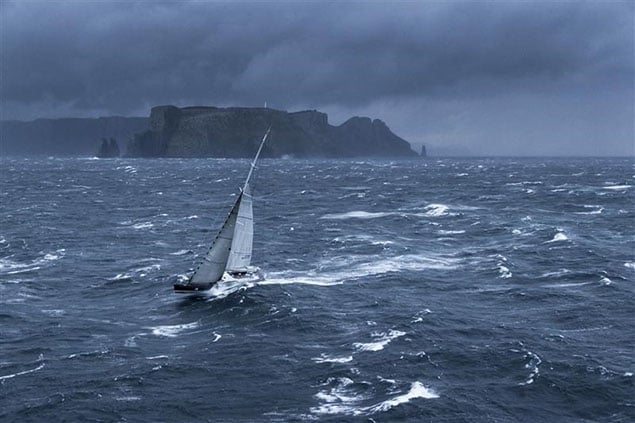 The waters of Tasmania in an unruly mood – the Swan 82 Nikata in the 2013 Rolex Sydney-Hobart Race. Photo Rolex
The waters of Tasmania in an unruly mood – the Swan 82 Nikata in the 2013 Rolex Sydney-Hobart Race. Photo Rolex
 Kilcullen Voyager may look ultra-modern to many sailors, yet she’s a ten year old veteran which lacks the hydrofoils of the most modern boats. Photo Team Ireland
Kilcullen Voyager may look ultra-modern to many sailors, yet she’s a ten year old veteran which lacks the hydrofoils of the most modern boats. Photo Team Ireland
As for Marcus Hutchinson, his challenges these past few days have been prodigious. Not only is he Race Director for the SMA team, but he and his colleagues have been giving a friendly hand to the much less heavily-resourced Team Ireland campaign which is doing what it can to keep the Enda O Coineen show on the road with the ten-year-old Kilcullen Voyager.
In fact, the two boats are light years apart, as SMA is one of the newest boats with hydrofoils (all five current leaders are so equipped, even if second-placed Alex Thomson Hugo Boss has lost his starboard foil), whereas Kilcullen Voyager is an old Mike Golding warhorse which has been round the block and then some.
 Paul Meilhart’s SMA has Marcus Hutchinson as Race Director, but after a very successful first half of the Vendee Globe, Meilhart is now out with a failed keel ram. Photo: Vendee Globe
Paul Meilhart’s SMA has Marcus Hutchinson as Race Director, but after a very successful first half of the Vendee Globe, Meilhart is now out with a failed keel ram. Photo: Vendee Globe
Yet now SMA is out of the race and the problem is to provide a rendezvous for her with a replacement keel ram which can be modified to fit her particular setup. But the doughty 60-year-old Enda O Coineen is still on track and moving steadily up the rankings despite setbacks which would have put many others out of contention.
The risks he’s had to take to keep it going defy the imagination. A sheet got well and truly fouled around one of his twin rudders, which meant he had to set the boat sailing on track such that the rudder was clear of the water on the weather side, and then he’d to clamber over that same wet and heaving side of the boat and perch on the rudder while he cleared the line.
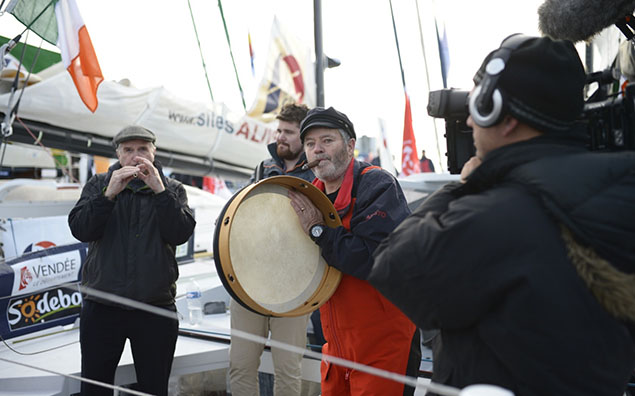 The party animal….Enda O Coineen with bodhran and cigar in Les Sables d’Olonne before the start
The party animal….Enda O Coineen with bodhran and cigar in Les Sables d’Olonne before the start
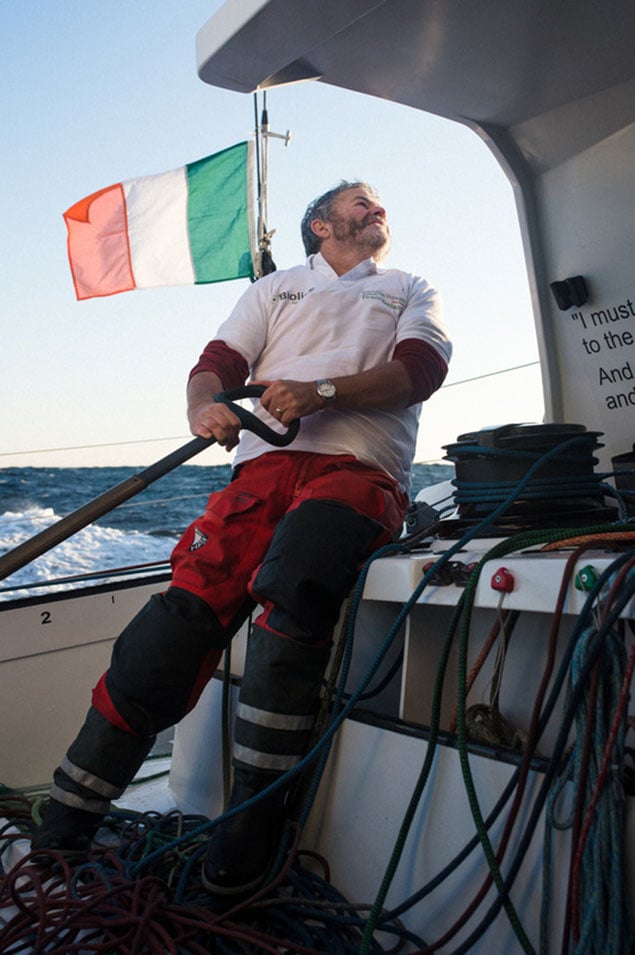 On his own, but the going is good. Enda O Coineen aboard Kilcullen Voyager getting the sort of sailing most of us dream of.
On his own, but the going is good. Enda O Coineen aboard Kilcullen Voyager getting the sort of sailing most of us dream of.
Even he admitted that he suffered a bit of a reaction to the all-or-nothing situation he had been in once he got safely back on deck. But since then his race has literally entered a darker phase as a massive knockdown has blanked out much of his electronics and knocked out his computer with the screen filled with water.
Even ashore in a fully-equipped workshop you’d be hard put to set that right. But in washing machine mode at top cycle, it’s a genius-defying predicament, yet his main men on land - Neil O’Hagan with Marcus Hutchinson - are doing everything possible while Marcus at the same time is seeing through the support programme for Paul Meilhart and the crippled SMA.
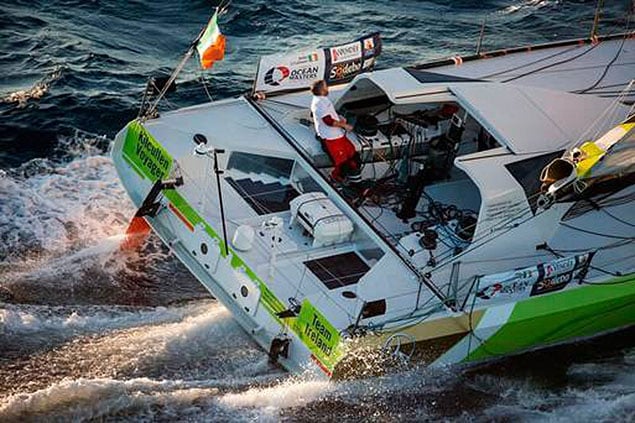 Aboard Kilcullen Voyager, the lone skipper has had a best day’s run of 395 miles. But now after electronic damage following a knockdown, he is back to basics with a small GPS and paper charts.
Aboard Kilcullen Voyager, the lone skipper has had a best day’s run of 395 miles. But now after electronic damage following a knockdown, he is back to basics with a small GPS and paper charts.
For Enda, it has been back to paper charts, a small GPS, and eyeball navigation with very red eyeballs. But by yesterday he was south of Australia, lying 13th overall out of 29 starters, and later today he hopes to be passing well south of Tasmania. Meanwhile in Sydney the crew of 88 boats will be having very controlled Christmas festivities as they keep themselves in competition-ready condition for the lunchtime start of the Rolex Sydney-Hobart Race on December 26th, with Tasmania and the Bass Strait very much in mind.
Back on December 14th, it was difficult to resist the temptation to draw smart-ass comparisons between the fact that a single-handed skipper racing in the Vendee Globe came whizzing through the Bass Strait for a brief experience of easier going, yet just two weeks later the crews the Hobart dash – the 72nd - reckon they’re the hard men (and women), and then some, to be facing into the crossing of the same Bass Strait.
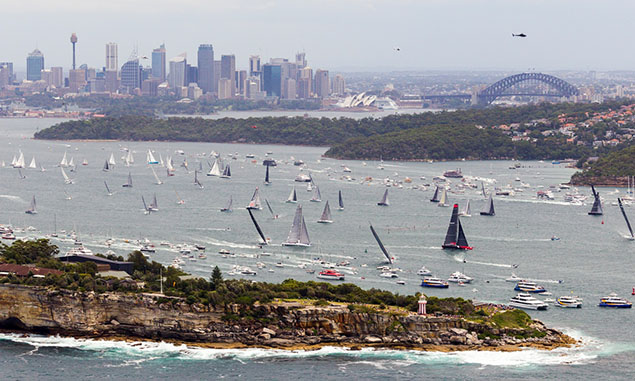 It’s an evocative part of world sailing’s fabric – the classic start of the Rolex Sydney-Hobart Race, down the harbour and out into the Tasman Sea. Photo Carlo Borlenghi/Rolex
It’s an evocative part of world sailing’s fabric – the classic start of the Rolex Sydney-Hobart Race, down the harbour and out into the Tasman Sea. Photo Carlo Borlenghi/Rolex
 The race to Hobart as popularly imagined – slugging it out across the Bass Strait. Photo Rolex
The race to Hobart as popularly imagined – slugging it out across the Bass Strait. Photo Rolex
But apart from the geographic proximity, comparisons are scarcely valid. The Rolex Sydney-Hobart Race is a 630-mile sprint in which mostly amateur crews endure oceanic conditions of all kinds for a relatively brief period of sometimes very scary stuff, knowing that at any time a port is within a day’s sail provided their boat hasn’t been totally incapacitated.
That said, people have been lost racing to Hobart, with six being drowned in 1998’s race when a storm swept through the Bass Straits. But it was a disaster from which much was learned and is unlikely to be repeated, even though the sudden changeability of the weather in the course region, despite it being the Australian summer, is something more extreme than in most European experience.
Nevertheless, the Vendee Globe, despite its huge media machine and technically savvy shore support teams, ultimately comes down to just one lone sailor racing an enormous and demanding machine with sails of a size which in times past would have been considered unthinkable as a solo command.
Admittedly when in the region of Tasmania, these skippers are mostly sailing downwind, whereas the crews racing to Hobart can expect a windward slugging match. But in the mighty flowing tapestry which is the weather of the Great Southern Ocean, every so often the approach of yet another low pressure system will force the Vendee Globe Skippers to put in some harsh windward work before the fronts sweep through and they can get back to the business of fast offwind sailing which recently has seen the race leaders pass Point Nemo, that imaginary spot in the Southern Ocean way south of the Pacific which is the furthest possible point on the planet from the nearest land – 1,670 miles.
That’s a helluva sight further from the nearest land than you’ll be when sailing in the Bass Strait, where Jeanne-Pierre Dick reported on his culture shock - after so many days of lone sailing on open ocean - at seeing evidence of habitation in the form of wind turbines. With all due respect to the skipper of St Michel-Virbac, most of us experience culture shock at seeing a formerly-beloved landscape suddenly polluted with wind farms, but we know what he meant.
Be that as it may, the very thought of Point Nemo is enough to give your ordinary human being the frights, but the Vendee Globe racers have to take it in their stride, in fact they scarcely notice it as the main points are the real land ones, with Cape Horn in all its notorious glory now coming centre stage.
On Monday, there’ll be 88 boats coming centre stage in the natural amphitheatre of Sydney Harbour, and with the time of year that’s in it, the Rolex Sydney-Hobart Race is one of the most keenly-followed sailing classics in the world for the simple reason that most of the world’s sailing population lives in the northern hemisphere, and it offers a wonderful escape from the rigours of a winter Christmas.
 The First 40 Breakthrough will have Ireland’s Barry Hurley as Sailing Master in Monday’s Rolex Sydney-Hobart Race
The First 40 Breakthrough will have Ireland’s Barry Hurley as Sailing Master in Monday’s Rolex Sydney-Hobart Race
There’s considerable Irish interest – after all, ex-Pat Gordon Maguire has won it twice – but as well there’s a natural fascination with the comparision of the performance of different boat types in what amounts to full-size laboratory conditions.
Last time round, Maguire’s owner Matt Allen put himself in the tricky position of having to choose at the last minute between taking his Carkeek 60 Ichi Ban or his TP 52 of the same name – both were race ready with days to go. In the end they plumped for the Carkeek, and she had a reasonably good race. But the irony of it all was that the overall winner was the 2008-vintage TP 52 Balance, owned by Australia’s popular financial guru Paul Clitheroe.
He’s probably extra-busy these days guiding people through Australia’s current mini-recession, which has the entry down to 88 boats. If this trend continues, in the foreseeable future the Volvo Round Ireland Race, with its entry numbers rising to 63 in 2016, could be matching the Rolex Sydney-Hobart in fleet size, which really would be one for the books.
But that’s another day’s work. Right now, we can find Irish interest in Sydney in Gordon Maguire as sailing master aboard the TP52 Ichi Ban, in Barry Hurley of Malta but still Royal Irish YC in his CV as Sailing Master of the First 40 Breakthrough with Kenneth Rumball in the crew, and in Shane Diviney, originally of Howth but getting up to speed these days with the professional multi-hull scene Down Under, who is a crew-member aboard the successful Judel Vrolik 62 Chinese Whispers.
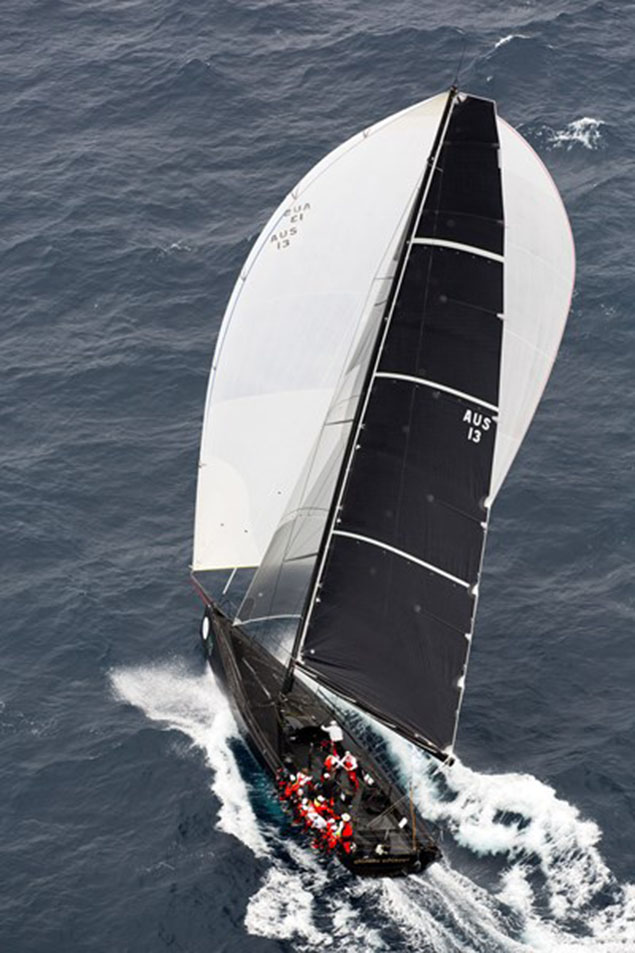 The successful JV62 Chinese Whispers has Ireland’s rising star Shane Diviney in her crew for the Rolex Sydney-Hobart Race.
The successful JV62 Chinese Whispers has Ireland’s rising star Shane Diviney in her crew for the Rolex Sydney-Hobart Race.
This is a boat which started life as Jethou purely for day racing at European venues, yet in Australia has proven to be a formidable performer offshore. As for others whose presence we might have expected, ace navigator Ian Moore – whose overall victory in the Middle Sea Race made him one of our “Sailors of the Month” in October – is taking a break to immerse himself in a family Christmas in Cowes after probably his most successful year ever, while for the rest of us the Rolex Sydney-Hobart Race will be a colourful interlude in the midst of the continuing mega-drama of the Vendee Globe.
Yesterday in this big one, the leader Armel Le Cleac’h rounded Cape Horn at 1234 UTC in Banque Populaire VIII with 595 miles in hand on the second-placed Alex Thomson in Hugo Boss. This margin may sound, well, it sounds stupendous – it’s just 35 miles short of the complete length of the Rolex Sydney-Hobart Race. But then the Vendee Globe is stupendous, and the men in it have shown themselves to be both superhuman and yet very human indeed.
 Banque Populaire VIII rounded Cape Horn at 1234 UTC yesterday. Photo Vendee Globe
Banque Populaire VIII rounded Cape Horn at 1234 UTC yesterday. Photo Vendee Globe
 Still racing. If the rate of attrition among other entries persists and his speed continues to improve, Enda O Coineen’s Kilcullen Voyager could finish in single figures in a race in which 29 started. Photo Team Ireland
Still racing. If the rate of attrition among other entries persists and his speed continues to improve, Enda O Coineen’s Kilcullen Voyager could finish in single figures in a race in which 29 started. Photo Team Ireland
Thus the really stupendous thing is that Enda O Coineen may be all of 5700 miles astern of the leader, yet we still feel he is very much racing. He is currently placed 13th overall, and he has it in him to move into single figures if the current rate of attrition persists, and he continues to show his guts and ingenuity in overcoming problems. His best day’s run – 395 nautical miles – was recorded as recently as December 9th.
Enda O Coineen arouses mixed feelings in those who have interacted with him in times past, but he has rightly endeared himself to the world, - and the Irish public in particular – with his tales of life on board the Kilcullen Voyager, and his delight in breaking into poetry at every opportunity. When the distinguished Tyrone-born poet John Montague passed away recently, Enda was right there with a reading from the great man’s works. But perhaps the most abiding member of this race will be from a sunny time when the going was good and Enda felt – with every justification – that the joys of the day merited a sunlit reading of Joseph Plunkett’s A Wave of the Sea, which certainly deserved it:
Kilcullen Voyager has even experienced poetry sessions
I am a wave of the sea
And the foam of the wave
And the wind of the foam
And the wings of the wind.
My soul’s in the salt of the sea
In the weight of the wave
In the bubbles of foam
In the ways of the wind.
My gift is the depth of the sea
The strength of the wave
The lightness of foam
The speed of the wind.
Now here in Ireland we are going through one winter storm after another, but the fishing boats are crowded safely in port, the Christmas homecoming flights have finally made it, and peace moves in on the land. It isn’t until Monday that the fleet races away down Sydney Harbour. Yet far out in the Southern Ocean and immediately past Cape Horn, those tiny specks are the Vendee Globe boats racing on through Christmas Eve, through Christmas Day, through everything. We wish them well, and wish everyone a very happy Christmas.
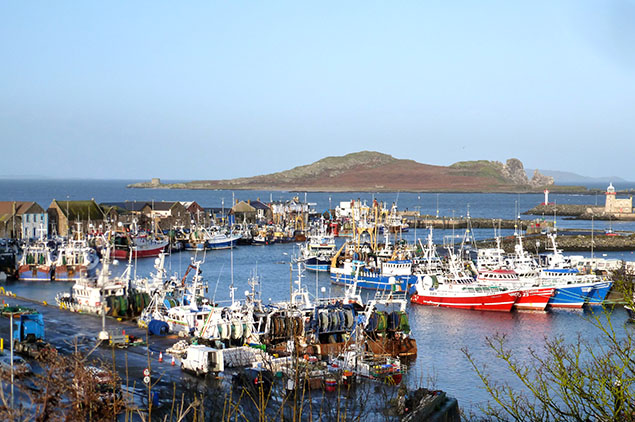 It’s Christmas, and the fishing fleet is safe in port. Howth as it was yesterday afternoon. Photo: W M Nixon
It’s Christmas, and the fishing fleet is safe in port. Howth as it was yesterday afternoon. Photo: W M Nixon
Enda O'Coineen 'Sailing in the Dark' As Storms Batter Vendee Globe Sailors
The past three or four days have 'not been good' for Ireland's first entry in the Vendee Globe Enda O'Coineen (IRL) Kilcullen Voyager-Team Ireland has suffered a knockdown in a storm and has lost some communications equipment.
'Like everyone else in this part of the fleet we experienced two bad blows one after the other, I recorded up to 50kts at one stage. The first storm was bad and then about ten hours later the second one and during it I took a very bad knock down and the boat was on her side for about five minutes. When I hear about some of the other competitors I know I am not on my own. I am devastated for some, I don't want to hear about boats running into things. You never know what is going to happen, it is in the lap of the gods. I will say a few prayers at Christmas.'
O'Coineen is among a group five boats approaching the longitude of Cape Leeuwin, the SW tip of Australia with in order Fabrice Amedeo (Newrest-Matmut), Alan Roura (La Fabrique), O'Coineen (Kilcullen-Team Ireland), Rich Wilson (Great American IV) and Eric Bellion (CommeUnSeulHomme).
O'Coineen has been forced into a back to basic approach to navigation and routing on Kilcullen Voyager in 17th place. He lost two places when he took time out routing to the north to avoid the worst of the hard weather after being knocked down for five minutes. The Irish skipper reports that he now has no useful computer output after his main computer screen was damaged by water. He has a problem with the configuring of his back up computer which, it is understood, will not boot up. And so he has resorted to GPS fixes and paper charts.
“I am sailing in the dark to a certain extent. What I did to recuperate was to sail north towards Perth. I thought it would be a nice place for Christmas. I changed my mind. I effectively stopped for two days. But yesterday I got myself a little bit back together and I headed and south and east and now I am going east,” O'Coineen said today, adding “Spirits are good right now. You go through highs and low points, in the day, in the cycle and over the week. I have certainly had a couple of tough days and have had a lot of damage. Our shore team are trying to find a solution.”
Video from December 15:



























